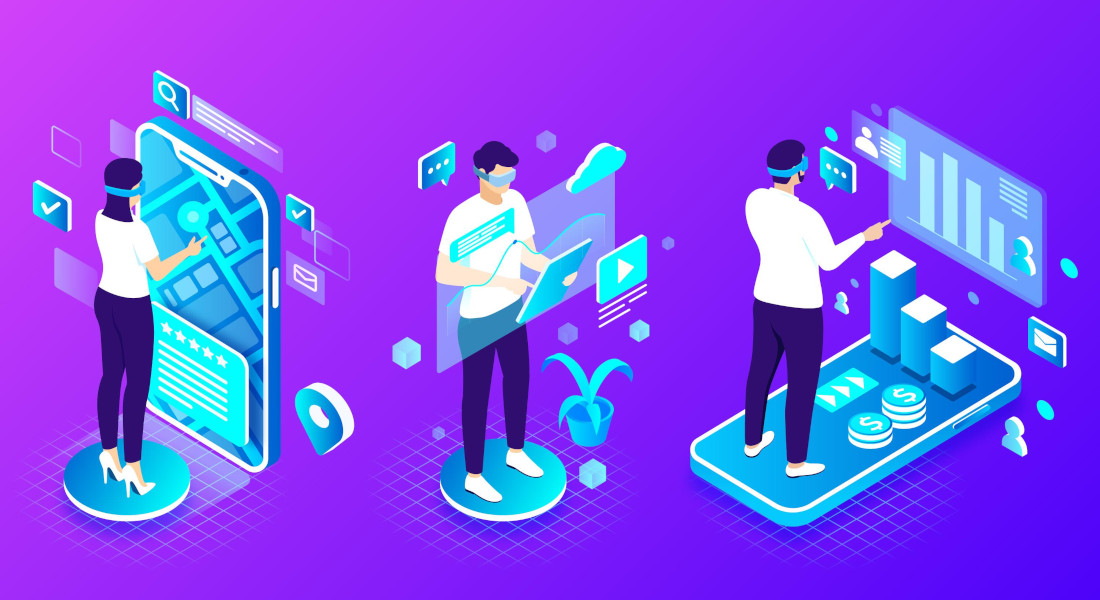We have prepared 10 successful case studies of how the development of augmented and virtual reality applications influenced business processes.
What are AR and VR?

Both technologies give the user a new level of immersion in the product offered. For companies, it is a way to expand the customer base and increase brand loyalty. For the user, it is a chance to have a new experience. Despite the apparent similarities, AR and VR are two different technologies:
- Augmented Reality (AR) is when text or multi-level computer graphics are projected onto objects in the real world. For this purpose, smartphones, special AR glasses, projectors, and other devices are used.
- Virtual Reality (VR) is a technology that creates an entirely virtual plane for presenting the information. It also uses special devices like VR headsets to immerse the user in a virtual world fully.
For example, NASA uses virtual reality to train future astronauts. Simulators created using VR allow for the effect of presence and help a person prepare for a flight into space. This includes a simulator for walking on the surface of Mars. It helps astronauts get used to the view of the red planet.
We also recommend you read Microservices Software Architecture: Everything You Should Know
What is the difference between AR and VR?

Virtual reality and augmented reality are concepts that seem synonymous at first glance. However, VR interacts with users, creating new worlds for them, while AR interacts with the outside world, supplementing it with new elements.
For example, Pokemon GO (a popular game in 2016-2017) is a successful example of augmented reality usage. In the game, Pokemons that must be caught are organically embedded in the environment. According to data for August 2019, the number of installations of the game has exceeded 1,000,000,000.
Today, AR glasses and VR headsets are featured in the product line of Google, Samsung, and other companies. If, in the early years, such a novelty was considered a luxury, today, the market value of a device for immersive AR and VR does not exceed the cost of a smartphone.
We also recommend you read 5 web development trends for 2023.
Where are augmented and virtual reality applied?

The application field of AR and VR apps is vast and only gets wider yearly. Gaming businesses, advertising agencies, educational platforms, and even religious organizations have embraced both technologies. AR and VR can be used for the following purposes:
- New product presentation. VR and AR applications can be used to present new products. VR and AR technologies offer such opportunities:
- Showing a 3D model of a product
- Virtual demonstration of product features
- Involvement of the audience in a presentation or event
- Education. VR and AR simulators have proven to be practical tools in education. The human brain remembers and absorbs information best when education is gamified. This is especially true for children's perceptions. Thanks to VR and AR, the quality and effectiveness of the educational program reach a new level. These technologies are already used by the world's leading universities and schools, allowing pupils and students to consider 3D models of atoms and chemical elements and obtain knowledge in an interactive form.
- Entertainment. The games and entertainment industry has made the most of the potential of augmented and virtual reality. A separate class of games has already been developed for special AR glasses and VR headsets, providing complete immersion in a new world. The advantage is immersion in the gameplay, achieved by realistic pictures, a 360 view, and control of the game with special joysticks, simulating the movement of hands. A person feels like a character in the game.
- Visualization projects. VR and AR are indispensable tools when it comes to visualizing 3D projects. For example, it is convenient to use augmented reality to present projects of construction companies. Buyers of apartments in the real estate at the stage of construction will see the future result realistically. They can even walk inside the future housing by wearing special AR glasses or VR headsets. Such visualization can increase sales because people really believe only in what they see. However, construction is not the only area where virtual technology is part of the marketing strategy.
- Virtual Avatars. Virtual avatars are used in virtual networks like metaverse and allow for realistic interactions. This can be either a gaming or social networking avatar, where communication is initially based on augmented and virtual reality technology. In addition, augmented and virtual reality technologies open the way to new opportunities in advertising and interaction with the content consumer. The effect of presence makes a strong impression on people and motivates them to act more than a banner ad or an advertising slogan.
Moreover, VR and AR have already begun to be used in the experimental treatment of mental disorders. With the help of these developments, doctors help people cope with phobias and post-traumatic stress.
We also recommend you read 5 fintech trends in 2023.
3 examples of VR applications
In the case of virtual reality, there are many impressive examples of VR applications. The case studies below will clearly show what tasks can be realized with the help of VR and AR technologies.
Fortnite

The first successful case study is DJ Marshmello's concert in Fortnite, which took place in 2019. As a result, 10 million people could attend the virtual concert, which lasted about 10 minutes in their homes. After the concert, Twitter was flooded with comments from viewers all over the world. For some, it was the only possible chance to get to DJ Marshmello's concert.
Thomas Cook

Many travel companies have already made virtual reality part of their operations. The Thomas Cook travel company is offering customers a virtual tour through a virtual reality app that will allow them to appreciate the benefits of their upcoming trip. For example, Thomas Cook Airlines created a tour based on finished flight recordings. After the release of the tour, the number of bookings increased by 180%.
SnowWorld

Virtual Reality has also found applications in medicine. For example, a game called SnowWorld was explicitly created for burn patients, and as a result, it helps people take their minds off the pain. According to studies, patients have rated a 20% reduction in pain levels.
4 examples of well-known AR applications
Familiar examples of AR use are global giants Snapchat and Instagram. Both apps have been among the most installed in the last 3 years. Both apps are social networks whose functionality is related to processing and publishing photos.
Snapchat

In 2018, the company announced its intention to launch an augmented reality search service. The platform is based on finding items scanned with a smartphone camera in stores. The project was planned to collaborate with Amazon. As a result, such a feature was launched in September 2018.

Popular Instagram mask filters are nothing more than an augmented reality tool. They help even out skin tone, change the color scheme of a picture and even add new details to your surroundings.
Instagram mask filters are used to retouch stories and live shows. According to statistics, more than 500 million people view stories on Instagram daily. Using branded mask filters will help attract new customers.
The world is watching for the opening

There are also examples of the use of augmented reality in the Ukrainian market. For example, a children's game from the TV channel PLUSPLUS released “The world is waiting for the opening" in 2019. It is a successful case of using AR to teach preschool children. More than 10 000 people have already installed the application.
IKEA

The IKEA Place application is also a successful example of augmented reality. With its help, people can try on new furniture. People can see whether the furniture will fit into the interior by pointing to where the new thing is supposed to stand. More than 1,000,000 people have already installed the app.
Tools for AR and VR development
VR/AR can be divided into several areas. The basic technology stack depends on what you choose:
- AR/VR development for VR headsets (games and apps for HTC Vive or Oculus Rift). The basic programming languages are C++ and React. Developers mainly use special game engines (Unreal Engine 4 and Unity) that allow for creating interactivity in 3D scenes.
- AR/VR development for mobile applications. The basic programming languages are Swift for iOS and Kotlin for Android.
- AR/VR development for the web. Three.js, Babylon.js, Node.js, and React 360 are used because they have ready-made tools for effects and camera view settings.
Other tools and technologies that may be required for VR/AR development:
- DirectX - for fully working with graphics solutions
- Vuforia - SDK for augmented reality, which understands how virtual buttons and markers work
- G'Audio or Spatial Workstation - to bind the sound to a specific point in the VR-space
- Recap360 - used to create 3D panoramas and 2D drawings that can then be edited
- Agisoft Photoscan - creates 3D models from photos
- Blender - a free tool for animation, rendering, and even motion capture
- Blocks - Google's tool for creating simple 3D models
- CryEngine - 3D modeling tool with DirectX 12 support
The AR/VR developers not only have to write code. They must also understand the UI/UX environment - how the program should respond to the user's reaction.
MaybeWorks expertise in AR and VR development

The last project where we assisted in AR/VR development was an application that allows users to create custom VR applications in a simple way. It is a high-quality alternative to traditional video platforms because users can upload the media needed, adjust the design to make it unique, send a request for building an application, and finally measure users' activity.
MaybeWorks AR/VR experts were hired as Full Stack Developers to deliver MVP in the shortest possible time with the best possible quality. To deliver this project successfully, our Full Stack Developers applied the best practices on how to develop an MVP, using JavaScript as a backend framework and and Angular for frontend, while working with both Google Cloud and Amazon Web Services on this project.
MaybeWorks AR/VR developers implemented:
- Video uploading workflow (together with integration with Twilio)
- Complex subscription payment gateway (initially Paypal, but have moved to Stripe finally)
- Complex analytics reports
- Subscription management via Maxio
- Authorization via Google/Facebook
It was a long but productive Agile run for MaybeWorks developers. As a result, now this project is something we can be proud of: this is an excellent implementation of an exciting business idea that has been successfully delivered to the market.
Feel free to contact us to discuss our assistance in AR/VR project development.















